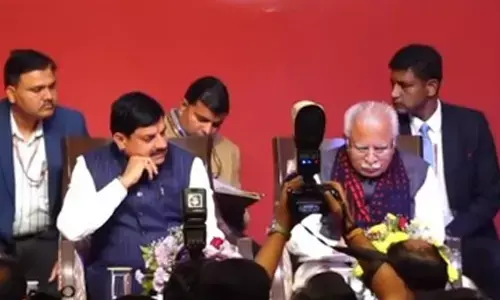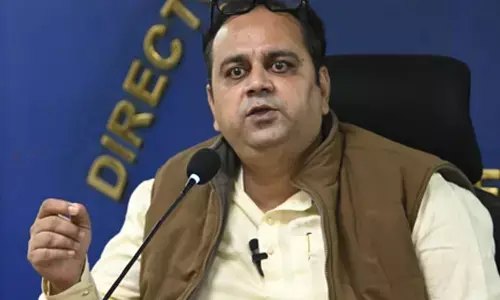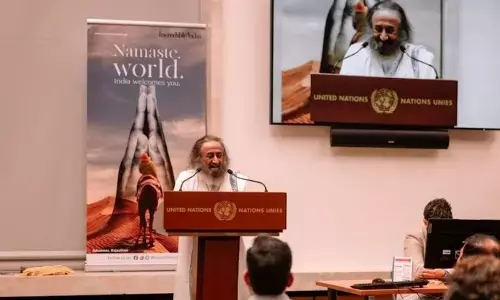A primer on India’s nuclear energy sector

Nuclear energy is undoubtedly most controversial, yet critical part for India’s future energy security. As we know India’s annual energy demand is expected to rise to 800 GW by 2032, it is very important to consider every snource of energy in the optimum energy mix.
Nuclear energy is undoubtedly most controversial, yet critical part for India’s future energy security. As we know India’s annual energy demand is expected to rise to 800 GW by 2032, it is very important to consider every source of energy in the optimum energy mix.
Arguments in favor of nuclear energy become even more compelling if we consider vast thorium reserves that India have. Yet there are strong and reasonable apprehensions against use of nuclear energy which can’t be ignored. Stress can be laid on cautious development, safety precautions in operations and disposal of wastes through continuous innovations, and also on minimization of waste generation.
But development of nuclear energy can’t be stonewalled because of such concerns.India Nuclear Program has roots in establishment of Tata Institute of Fundamental Research in 1945 with initiative Dr. H. Bhabha. It undertook research in nuclear physics and cosmic rays.
In 1948 Atomic Energy Commission was constituted to work for Indian Nuclear Program. Main area of commission was prospection of nuclear raw material resources of the country. India has insufficient Uranium reserves of 1-2% of global reserves, but is endowed with one of the largest reserves of Thorium which constitute about 30 % of global reserves.
Thorium however is not fissile and can’t be used directly to trigger Nuclear Reaction. But it is ‘fertile’ and what makes it Nuclear Fuel is the fact that its isotope Thorium – 232 can be converted to Uranium -233 which is ‘fissile’. This process of conversion is called ‘Transmutation’. To exploit Thorium reserves Dr. Homi Jehangir Bhabha conceived ‘3 Stage Nuclear Program’ which is explained below.
• India’s three-stage nuclear power programme was formulated by Homi Bhabha in the 1950s to secure the country’s long term energy independence, through the use of uranium and thorium reserves found in the monazite sands of coastal regions of South India.
The ultimate focus of the programme is on enabling the thorium reserves of India to be utilized in meeting the country’s energy requirements.
• Thorium is particularly attractive for India, as it has only around 1–2% of the global uranium reserves, but one of the largest shares of global thorium reserves.
• However, at present thorium is not economically viable because global uranium prices are much lower.
• The recent Indo-US Nuclear Deal and the NSG waiver, which ended more than three decades of international isolation of the Indian civil nuclear programme, have created many hitherto unexplored alternatives for the success of the three-stage nuclear power programme.
• Thorium itself is not a fissile material, and thus cannot undergo fission to produce energy.
• Instead, it must be transmuted to uranium-233 in a reactor fueled by other fissile materials [plutonium-239 or uranium-235].
• The first two stages, natural uranium-fueled heavy water reactors and plutonium-fueled fast breeder reactors, are intended to generate sufficient fissile material from India’s limited uranium resources, so that all its vast thorium reserves can be fully utilized in the third stage of thermal breeder reactor.
Stage I – Pressurized Heavy Water Reactor [PHWR]
• In the first stage of the programme, natural uranium fuelled pressurized heavy water reactors (PHWR) produce electricity while generating plutonium-239 as by-product.
[U-238 ] Plutonium-239 + Heat]
[In PWHR, enrichment of Uranium to improve concentration of U-235 is not required. U-238 can be directly fed into the reactor core]
[Natural uranium contains only 0.7% of the fissile isotope uranium-235. Most of the remaining 99.3% is uranium-238 which is not fissile but can be converted in a reactor to the fissile isotope plutonium-239].
[Heavy water (deuterium oxide, D 2O) is used as moderator and coolant in PHWR].
• PHWRs was a natural choice for implementing the first stage because it had the mostefficient reactor design [uranium enrichment not required] in terms of uranium utilisation.
• India correctly calculated that it would be easier to create heavy water production facilities (required for PHWRs) than uranium enrichment facilities (required for LWRs).
• Almost the entire existing base of Indian nuclear power (4780 MW) is composed of first stage PHWRs, with the exception of the two Boiling Water Reactor (BWR) units at Stage II – Fast Breeder
Reactor
• In the second stage, fast breeder reactors (FBRs)[moderators not required] would use plutonium-239, recovered by reprocessing spent fuel from the first stage, and natural uranium.
• In FBRs, plutonium-239 undergoes fission to produce energy, while the uranium-238 present in the fuel transmutes to additional plutonium-239.
transmuted to Plutonium-239?
Uranium-235 and Plutonium-239 can sustain a chain reaction. But Uranium-238 cannot sustain a chain reaction. So it is transmuted to Plutonium-239.
But Why U-238 and not U-235?
Natural uranium contains only 0.7% of the fissile isotope uranium-235. Most of the remaining 99.3% is uranium-238.
• Thus, the Stage II FBRs are designed to “breed” more fuel than they consume.
• Once the inventory of plutonium-239 is built up thorium can be introduced as a blanket material in the reactor and transmuted to uranium-233 for use in the third stage.
• The surplus plutonium bred in each fast reactor can be used to set up more such reactors, and might thus grow the Indian civil nuclear power capacity till the point where the third stage reactors using thorium as fuel can be brought online
• As of August 2014, India’s first Prototype Fast Breeder Reactor at Kalpakkam had been delayed – with first criticality expected in 2015, 2016..and it drags on.
Stage III – Thorium Based Reactors
• A Stage III reactor or an Advanced nuclear power system involves a self-sustaining series of thorium-232-uranium-233 fuelled reactors.
• This would be a thermal breeder reactor, which in principle can be refueled – after its initial fuel charge – using only naturally occurring thorium.
• According to replies given in Q&A in the Indian Parliament on two separate occasions, 19 August 2010 and 21 March 2012, large scale thorium deployment is only to be expected 3 – 4 decades after the commercial operation of fast breeder reactors. [2040-2070]
• As there is a long delay before direct thorium utilisation in the three-stage programme, the country is now looking at reactor designs that allow more direct use of thorium in parallel with the sequential three-stage programme
• Three options under consideration are the Accelerator Driven Systems (ADS), Advanced Heavy Water Reactor (AHWR) and Compact High Temperature Reactor
Prototype Fast Breeder Reactor at Kalpakkam
• The Prototype Fast Breeder Reactor (PFBR) is a 500 MWe fast breeder nuclear reactor presently being constructed at the Madras Atomic Power Station in Kalpakkam, India.
• The Indira Gandhi Centre for Atomic Research (IGCAR) is responsible for the design of this reactor.
• As of 2007 the reactor was expected to begin functioning in 2010 but now it is expected to achieve first criticality in March-April 2016.
• Construction is over and the owner/operator, Bharatiya Nabhikiya Vidyut Nigam Limited (BHAVINI), is awaiting clearance from the Atomic Energy Regulatory Board (AERB).
• Total costs, originally estimated at 3500 crore are now estimated at 5,677 crore.
• The Kalpakkam PFBR is using uranium-238 not thorium, to breed new fissile material, in a sodium-cooled fast reactor design.
• The surplus plutonium or uranium-233 for thorium reactors [U-238 transmutes into plutonium] from each fast reactor can be used to set up more such reactors and grow the nuclear capacity in tune with India’s needs for power.
• The fact that PFBR will be cooled by liquid sodium creates additional safety requirements to isolate the coolant from the environment, since sodium explodes if it comes into contact with water and burns when in contact with air.
What Hinders Deployment of Thorium-Fuelled Reactors In India?
• Most people would assume that it is a limitation of technology. But instead, it is due toshortage of uranium fuel that is needed to convert fertile fuel [thorium] into fissile[fuel that can undergo sustained chain reaction].
• Scientists at the Bhabha Atomic Research Centre have successfully tested all relevant thorium-related technologies in the laboratory.
• In fact, if pressed, India could probably begin full-scale deployment of thorium reactors in ten years.
• The single greatest hurdle, to answer the original question, is the critical shortage of fissile material.
What is a fissile material?
• A fissile material is one that can sustain a chain reaction upon bombardment by neutrons.
• Thorium is by itself fertile, meaning that it can transmute into a fissile radioisotope [U-233] but cannot itself keep a chain reaction going.
• In a thorium reactor, a fissile material like uranium or plutonium is blanketed by thorium.
• The fissile material, also called a driver in this case, drives the chain reaction to produce energy while simultaneously transmuting the fertile material into fissile material.
• India has very modest deposits of uranium and some of the world’s largest sources of thorium. It was keeping this in mind that in 1954, Homi Bhabha envisioned India’s nuclear power programme in three stages to suit the country’s resource profile.
1. In the first stage, heavy water reactors fuelled by natural uranium would produceplutonium [U-238 will be transmuted to Plutonium 239 in PHWR];
2. The second stage would initially be fuelled by a mix of the plutonium from the first stage and natural uranium. This uranium would transmute into more plutonium and once sufficient stocks have been built up, thorium would be introduced into the fuel cycle to convert it intouranium 233 for the third stage [thorium will be transmuted to U-233 with the help plutonium 239].
3. In the final stage, a mix of thorium and uranium fuels the reactors. The thorium transmutes to U-233 which powers the reactor. Fresh thorium can replace the depleted thorium [can be totally done away with uranium which is very scares in India] in the reactor core, making it essentially a thorium-fuelled reactor [thorium keeps transmuting into U-233. It is U-233 that generates the energy].
Present State of India’s Three-Stage Nuclear Power Programme
• After decades of operating pressurized heavy-water reactors (PHWR), India is finally ready to start the second stage.
• A 500 MW Prototype Fast Breeder Reactor (PFBR) at Kalpakkam is set to achieve criticality any day now and four more fast breeder reactors have been sanctioned, two at the same site and two elsewhere.
• However, experts estimate that it would take India many more FBRs and at least another four decades before it has built up a sufficient fissile material inventory to launch the third stage.
Solution to India’s Fissile
Shortage Problem – Procuring Fissile Material Plutonium
• The obvious solution to India’s shortage of fissile material is to procure it from the international market.
Favourable Conditions for Plutonium Trade
• As yet, there exists no commerce in plutonium though there is no law that expressly forbids it.
• In fact, most nuclear treaties such as the Convention on the Physical Protection of Nuclear Material address only U-235 and U-233.
• This is because Plutonium has so far not been considered a material suited for peaceful purposes.
• The Non-Proliferation Treaty (NPT) merely mandates that special fissionable material — which includes plutonium — if transferred, be done so under safeguards.
• Thus, the legal rubric for safeguarded sale of plutonium and safety procedures for moving radioactive spent fuel and plutonium already exists but it is not too complicated as in case Uranium.
• Japan and the U.K. who are looking to reduce their stockpile of plutonium will certainly be happy to sell it to India.
What compelling reason does the world have to accommodate India?
• India’s FBRs that are tasked for civilian purposes and can be brought under international safeguards in a system similar to the Indo-U.S. nuclear deal.
• FBRs and large quantities of fissile material can easily be redirected towards weapons programme. But India has shown no inclination to do so until now.
Obstacles
• The U.S. could perhaps emerge as the greatest obstacle to plutonium commerce.
• The U.S. cannot prevent countries from trading in plutonium, it has the power to make it uncomfortable for them via sanctions, reduced scientific cooperation, and other mechanisms.
• The strong non-proliferation lobby in the U.S. would not like a non-signatory of the NPT [India] to open and regulate trade in plutonium.
• The challenge for Delhi is to convince Washington to sponsor rather than oppose such a venture.
India’s Nuclear DealsIndo US Nuclear – It was landmark deal, signed in 2008, which resulted in end of India’s isolation for civil nuclear technology and supply nuclear fuel. After 1972’s Pokhran tests, there were sanctions on India which prohibited all countries to supply anything for India’s nuclear program.
But it placed India’s civil nuclear installations under watch of International Atomic Energy agency subject to India’s ratification of ‘Additional protocol’ which it did recently. Under this agreement US expected to supply India nuclear Reactors. US nuclear corporate lobby was decisive force behind this agreement.
Consequently, there was ‘India specific waiver’ by Nuclear Supplier’s Group, which was vehemently opposed by China. Now India is only country outside NSG’s 5 member (US, UK, China, France & Russia) who possess nuclear weapon but is allowed to trade in Civil Nuclear Materials.
(Japan & Germany are non-nuclear powers as they enjoy US umbrella)Similar deals were entered in with France, South Korea and latest with Australia.But other contentious issue has been of Civil Nuclear Liability Act of India. It originally held that on accident operator (which as of now will be NPCIL) has liability up to Rs 500 crores and rest will be paid by government.
This provision has significance only if government intends to privatize Nuclear Plant operations.Further, Operator can claim compensation up to 1500 crore from foreign supplier, if provision to this regard is there in contract.
Another provision states that, if on accident patent or latent defect is established in components supplied or damage is result of intentional act or omission by the supplier, then right to compensation will be unlimited. For this operator can sue supplier. Time for compensation is fixed at 10 years This is contrary to international law on nuclear liability agreed upon in Vienna Convention, which keep supplier aloof from any liability. Hence liability of Operator is absolute.
This while safeguarding Indian interests has kept nuclear suppliers away from India. Since this law came in force, not a single new deal has been agreed at.
Nuclear plants consist of thousands of components manufactured by different companies. If any single supplier doesn’t agree with this clause, then whole deal will get down.
Nuclear supplier claims that probability of nuclear accident is extremely low (once in thousands of years). But there have been accidents like Chernobyl, Ukraine where 31 people died and costs were as high as 18 billion $ in 1987. Similarly recently in Fukushima, Japan nuclear installations got damaged in a Tsunami and there has been huge radioactive contaminations since then. In India, given its fragile ecology and dense population, loss if any will be significantly higher.
And also this is a Human Right issue for people affected. Civil Nuclear Law of India doesn’t give power to sue to victims, but to operators.
1. AERB is responsible for regulating and monitoring the safety aspects of DAE. But, DAE provides Technical, financial and staff support to AERB.
2. Secretary to government of DAE is Ex officio chairman of AEC. And yet later is expected to oversee former and formulate policy.
Bedrock principle of any regulator is that it should be independent of influence of the organization which it is expected to oversee or regulate. But here we can see there is inherent conflict of interest and Nuclear energy is an issue so important and vulnerable that such loophole is affordable.
Further Atomic Energy act of 1962, protects information related to nuclear establishment and empowers DAE to deny information. This is opposed by environmentalists and others on the ground that people have right to know everything about them, so as to be aware of risks associated.
This issue is controversial as disclosure of some information can jeopardize national security interest. Still there can be greater disclosures regarding safety and risks of particular technology, so that there could be more informed and productive debate when projects are conceived at first place.
Target set by DAE is that by 2050 33 % of India’s total electricity requirement by 2050 will be from nuclear power. This comes out to be about 275000 MW. This target seems unachievable and undesirable because of following concerns –
1. India’s domestic Uranium Reserve can support only 10000 MW of energy. So our future potential depends upon development of third stage of Nuclear Program. Otherwise, there will be again overdependence upon imported Uranium as it is case with Oil currently. Hence, long term strategy will be only determined when third stage is functional.
2. Current Nuclear reactors consume significant amount of water. So most of upcoming plants will be set up near sea costs. It will put pressure on the coastline as India’s Western coastline is home to fragile ecology of Western Ghats.
3. Further, till now only 21 plants have been operational. There are long gestation periods which increase costs of the plant significantly. Only a Nuclear Industry revolution in the future in nuclear energy can make this achievable.
4. New safeguard requirements post Fukushima disaster, has pushed per MW costs of nuclear reactors significantly higher in comparison to Thermal, solar and wind plants. Jaitapur plant in Maharashtra (AREVA) is expected to cost 21 crore/ MW in comparison other sources cost 8-10 crore/ MW. It is to be seen that whether differences of operational/ running costs justify such higher capital expenditure on nuclear plants.
5. Some argue that Total costs of a Nuclear Lifecycle which involves Mining of Uranium, transportation and storage, capital costs of plants , processing/ reprocessing of plants, possible disasters and then handling of waste generated for hundreds of years is significantly more that economic value generated during lifetime of the functioning of the plant, which is generally 40-50 years.
6. Nuclear installations will be favorite targets of terrorists (also in case of war) which can cause irreversible damage to people living in nearby areas.
7. In long run if worldwide dependence on Nuclear energy increases, it will be most unavoidable way of nuclear proliferation as interest and attempt to invest in indigenous industry will increase. Otherwise smaller counties will continue to buy relevant technologies or components from a few western countries which will serve private interest of few.
8. India doesn’t yet have credible waste disposal policy and infrastructure in place.
Strong arguments which justify use of nuclear energy are
1. No greenhouse gasses are emitted in Nuclear Power generation and in this way environmental costs are significantly less.
2. Quantities of nuclear fuel needed are considerably less than thermal power plants. Fr eg 10000 MW generation by coal will need 30-35 million tons of coal, but nuclear fuel needed will be only 300-350 tons.
3. It generates very limited waste in quantity (though far more hazardous in quality).
Costs of Nuclear Power in India
• The nuclear power tariffs are competitive with those of thermal power stations located away from coal pitheads. The tariffs of one station Tarapore 1&2 are 94 paise/kWh and that of three other older stations (like Narora) is about Rs.2. In the year 2007-08 the average tariff of nuclear power stations was Rs.2.28.
• The average tariffs of new plants to be set up, both indigenous and imported, is expected to be about Rs. 2.50 in the year 2015.
• But costs of power from new nuclear reactors are increasing significantly. New PHWR power costs between Rs. 6.2-6.5/Unit and as we have seen if we take whole nuclear life cycle costs, it will be even more.
• We can conclude that nuclear energy, though is critical for India’s energy security but is not panacea for the problem. People of India have right to have safe and sustainable energy. So future development should depend upon cost benefit analysis taking into account all the externalities involved in various components of energy mix.
If this is done, it is most likely that policy will get incline strongly in favor of non-conventional sources of energy that is solar, wind and biomass.
By Gudipati Rajendera Kumar
















